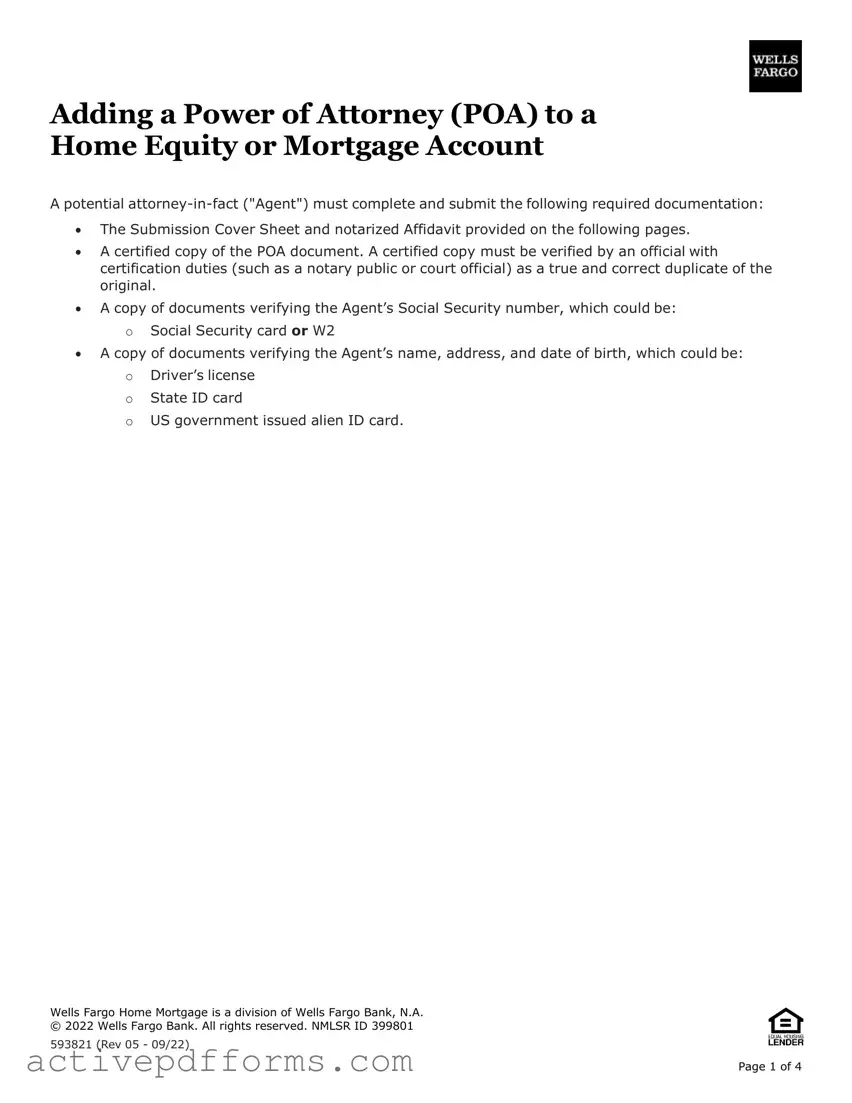Adding a Power of Attorney (POA) to a
Home Equity or Mortgage Account
Apotential attorney-in-fact ("Agent") must complete and submit the following required documentation:
•The Submission Cover Sheet and notarized Affidavit provided on the following pages.
•A certified copy of the POA document. A certified copy must be verified by an official with certification duties (such as a notary public or court official) as a true and correct duplicate of the original.
•A copy of documents verifying the Agent’s Social Security number, which could be:
oSocial Security card or W2
•A copy of documents verifying the Agent’s name, address, and date of birth, which could be:
oDriver’s license
oState ID card
oUS government issued alien ID card.
Wells Fargo Home Mortgage is a division of Wells Fargo Bank, N.A.
© 2022 Wells Fargo Bank. All rights reserved. NMLSR ID 399801 593821 (Rev 05 - 09/22)
Page 1 of 4

Power of Attorney Submission Cover Sheet
Please complete all sections of the form below and submit it with your Power of Attorney documents. Incomplete submissions may be delayed in processing or may be declined.
(A)Principal Information:
The “Principal” is the Borrower or Accountholder (the person for whom the Agent will be acting).
Today’s Date (mm/dd/yyyy) |
Account Number |
|
|
|
|
Principal Name |
|
|
|
|
|
Principal Street Address |
|
|
|
|
|
City |
State |
ZIP Code |
|
|
|
Principal Phone Number |
Principal Alternate Phone Number |
|
|
|
(B)Agent Information: To help the government fight the funding of terrorism and money laundering activities, Federal law requires all financial institutions to obtain, verify, and record information that identifies each person who opens an account. You must provide your name, address, date of birth, and other information that will allow us to identify you.
The “Agent” is the person who will be using the Power of Attorney to act on the Principal’s behalf.
Agent Name (First, Middle, Last)
Agent Street Address
City |
|
State |
ZIP Code |
|
|
|
|
Agent Phone Number |
Agent Date of Birth (mm/dd/yyyy) |
Agent Social Security Number |
|
|
|
|
Are you a U.S. citizen? |
|
Are you a permanent resident |
alien? |
Yes |
|
Yes |
|
No |
|
No |
|
|
|
|
Relationship to Principal |
|
How long have you known the Principal? |
|
|
|
|
Agent Occupation:
Executive/Professional |
Office |
Student |
Other |
Homemaker |
Production |
Teacher |
|
Labor |
Retired |
Trade |
|
Military/Diplomat/Government Official Manager |
Sales |
Unemployed w/ income |
|
Owner |
Service |
Unemployed w/o income |
|
To help us better understand the nature of the request, please advise specifically what types of requests the Agent will be doing on the Principal’s account and the purpose of the requests going forward: (must check at least one; check all that apply)
Payments Only |
Update Account Information |
Inquiries |
Make Advances (lines of credit only) |
Wells Fargo Home Mortgage is a division of Wells Fargo Bank, N.A. © |
|
2022 Wells Fargo Bank. All rights reserved. NMLSR ID 399801 |
|
593821 (Rev 05 - 09/22) |
Page 2 of 4 |
General Awareness |
Close Account (lines of credit only) |
Obtain Documentation |
Other: (please explain) |
|
____________________________________________________________ |
In an effort to protect the privacy of our borrower, please indicate the need for a Power of Attorney:
(must check at least one; check all that apply)

 Principal Overseas
Principal Overseas

 Possible Future Need
Possible Future Need

 Medical Purposes
Medical Purposes

 Other: (please explain)
Other: (please explain)
_________________________________________________________________________________________
Is the Principal incapacitated or otherwise unable to care for his/her financial affairs? An “incapacitated” person may not be able to make or communicate responsible personal decisions; and/or may exhibit an inability to meet his/her own personal needs for medical care, nutrition, clothing, shelter, or safety.
(you must check either yes or no)

 Yes
Yes

 No
No
You can submit your request by mail or fax to:
Wells Fargo
PO Box 10335
Des Moines, IA 50306
Home Equity
Fax: 1-866-834-7850
Home Mortgage
Fax: 1-866-590-8910
Wells Fargo Home Mortgage is a division of Wells Fargo Bank, N.A. © |
|
2022 Wells Fargo Bank. All rights reserved. NMLSR ID 399801 |
|
593821 (Rev 05 - 09/22) |
Page 3 of 4 |
AFFIDAVIT
I, ________________________________________________ having a mailing address of
_____________________________________________________________________________________________
being duly sworn, hereby make the following statements based upon my personal knowledge:
1.I am the Attorney-in-Fact/Agent/under a power of attorney from ______________________________________
(the Principal), which power of attorney is dated _______________________, ________. (Please insert the date that the original Power of Attorney document was signed by the Principal)
2.As of this date:
•The power of attorney has not been amended, revoked or terminated by the Principal;
•The principal has not died;
•If I am the spouse of the Principal, no action for divorce, annulment or separation has been commenced by me or the Principal;
•A guardian has not been appointed for the Principal.
3.I have examined the legal descriptions(s), if any, attached to the power of attorney and certify that the description(s) have not been changed, replaced, or amended subsequent to the signing of the power of attorney by the Principal.
4.I make this affidavit with the intention that it be relied upon by Wells Fargo Bank, N.A, in connection with a loan or line of credit to the Principal, secured by a mortgage or deed of trust of the Principal’s real estate (the “transaction”).
5.For purposes of the transaction, I understand that Wells Fargo will continue to rely on the representations contained in this affidavit after the loan or the line of credit is opened. I will promptly notify Wells Fargo of any future modification or revocation by the Principal.
6.I certify that I am submitting a true and correct duplicate of the original power of attorney.
7.For Line of Credit Products Only: If I am granted the power to make advances, I certify that any advances I make are only going to be utilized strictly for the benefit of the Principal and/or the collateral. The Bank may suspend the use of the Account and prohibit future advances during the Draw Period for any reason permitted by applicable law and/or the Account documents.
Initials ________
I declare under penalty of perjury that the information I have provided in this Affidavit and Cover Sheet is true and correct. Knowingly submitting false information on this form could subject you to civil and/or criminal prosecution.
Signed this _________day of ________________________, 20_____
_________________________________________ (Signature of Agent)
State of _______________________County of __________________________ Date _______________
This document was acknowledged and sworn to before me by ____________________________________ (Insert
name of the person signing the affidavit). They have presented the original Power of Attorney and I certify that this is a true and correct duplicate.
Signature of Notarial Officer ____________________________________________
Printed Name of Notarial Officer _________________________________________
Commission Expires: _______________ |
(Place seal of notary in the space below) |
A notary public or other officer completing this certificate verifies only the identity of the individual who signed the document, to which this certificate is attached, and not the truthfulness, accuracy, or validity of that document.
Wells Fargo Home Mortgage is a division of Wells Fargo Bank, N.A. © |
|
2022 Wells Fargo Bank. All rights reserved. NMLSR ID 399801 |
|
593821 (Rev 05 - 09/22) |
Page 4 of 4 |
|





 Principal Overseas
Principal Overseas
 Possible Future Need
Possible Future Need
 Medical Purposes
Medical Purposes


 Yes
Yes
 No
No